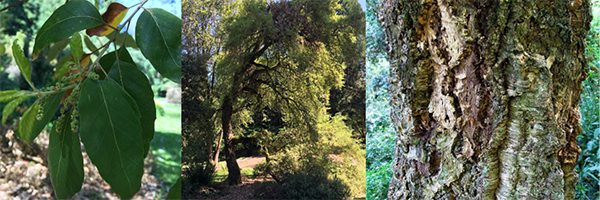Cork is a versatile material. It’s lightweight, impermeable, elastic, and a great insulator. All that and it’s biodegradable, renewable, recyclable, and it comes from a tree! Cork oak (Quercus suber), the source of most of the cork harvested commercially in the world, is native to the Mediterranean region and grows abundantly in Portugal, Spain, southern France, Algeria, Morocco, and Tunisia. It’s a medium sized evergreen reaching 65 feet tall. It has deeply fissured bark, weakly lobed leaves with a slight point, and acorns that are held loosely in their caps.
The ‘cork’ of the cork oak is actually the bark of the tree. It’s harvested from living trees to create stoppers for wine bottles, flooring, bulletin boards, and more. The first harvest of cork occurs when the tree is 25 years old. The bark is carefully removed in sections from the tree to avoid damaging the underlying tissue. The bark is allowed to grow back and in another 12 years, the cork will be harvested again.
These first two harvests are of a lower quality and commonly used for composite cork products like flooring. Nine or 10 years after the second harvest the third harvest takes place. This produces a high quality cork that can be used for stoppers in wine bottles. High quality harvests will take place every 9 or 10 years after that for 16 or so cycles, about 200 years.
Cork oaks are highly prized in Portugal where around 50% of the world’s cork harvest occurs. Cork trees have protected status there and cannot be cut down without special permission from the government.
 The Washington Park Arboretum is home to 5 cork oaks. The two largest were acquired from the UW Medicinal Herb Garden and were planted in the Arboretum in 1958. Another was received as seed from the Bordeaux Botanic Garden in France and planted in 1997. The youngest of the five trees were planted in 2015.
The Washington Park Arboretum is home to 5 cork oaks. The two largest were acquired from the UW Medicinal Herb Garden and were planted in the Arboretum in 1958. Another was received as seed from the Bordeaux Botanic Garden in France and planted in 1997. The youngest of the five trees were planted in 2015.
Genus:
Quercus
Family: Fagaceae (Beech family)
Location: All of the Arboretum's cork oaks are in the Mediterranean section along the east side of Arboretum Drive E, just south of the Fiddleheads Forest School (grids 20-3E through 22-4E).
Origin: Mediterranean Basin
Habit: Up to 65 feet high and wide.


No comments:
Post a Comment